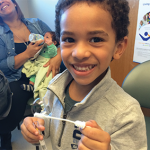
BOSTON—Eight pediatric academic centers have collaborated since 2009 to develop an open-science community that shares electronic medical record data to help them take better care of their patients. PEDSnet is one of the several clinical data research networks funded by the Patient-Centered Outcomes Research Institute (PCORI) that are dedicated to the mission of helping people make informed healthcare decisions.
During the session, Translating Patient-Centered Outcomes to the Real-World Setting, at the ACR/ARHP Annual Meeting in Boston in November 2014, Charles Bailey, MD, PhD, said that each patient encounter is an opportunity to “learn from this patient how to take better care of other patients.”
With the overall goal of patient-centered outcomes research, PEDSnet is building a network for sharing standardized clinical data, capturing longitudinal data and maintaining reliable interoperability between other research networks. By participating in a collaboration designed for continuous improvement, healthcare professionals can continue to “uphold the trust that patients place in us as clinicians,” said Dr. Bailey, assistant professor of clinical pediatrics at the Children’s Hospital of Philadelphia.
Structured data are captured at every encounter, an essential part of the clinical data research network that provides the necessary infrastructure to its members, according to research published by Dr. Bailey and colleagues.1 “As the underlying digital infrastructure to a [learning health system], PEDSnet will enable the rapid implementation of new evidence into clinical practice and will address fundamental questions of clinical effectiveness for children and their families, particularly for individuals affected by serious, and generally rare, illness that persists into adulthood.”1
Opportunities for Observational Research
PEDSnet includes eight children’s hospital health systems; patient-power research networks (PPRNs) that focus on pediatric inflammatory bowel syndrome, hypoplastic left heart syndrome and child obesity; and two national data partners.
‘The model…works,’ Dr. DeWitt said. It focuses on outcomes because ‘you don’t know how you are doing unless you measure it.’
Sharing electronic health record (EHR) data enables observational research that has broad depth and breadth, with information about a diverse population of patients in a real-world setting. This “pediatric learning health system” is forming communities of patients, families, clinicians, researchers and health system leaders who work to produce and use healthcare data generated in routine clinical care settings and to facilitate observational research and clinical trials based on those data. Most importantly, PEDSnet depends on the active participation of patients and their families. Success of the collaboration is dependent on the impact the system can have on the lives of patients and what is important to them and their families, Dr. Bailey said.
Another speaker at the session, Laure Gossec, MD, PhD, professor of rheumatology at Pierre and Marie Curie University in Paris, noted that what physicians consider important outcomes may not match what patients consider most important. The scores that are used to rate the impact of RA have not always considered lifestyle issues most relevant to patients, such as pain, sleep and fatigue. She is working within OMERACT to ensure better assessment tools that capture the patient perspective. OMERACT, Outcome Measures in Rheumatology, has developed guidelines for patient participation in research and established a guide for including patient-reported outcomes.
PR-COIN, or Pediatric Rheumatology Care and Outcomes Improvement Network, is one network of rheumatologists, nurses, therapists, social workers and others at rheumatology centers who are creating a registry database to measure their performance and inform themselves about patient-centered outcomes associated with juvenile idiopathic arthritis (JIA). Esi M. Morgan DeWitt, MD, MSCE, associate professor at Cincinnati Children’s Hospital Medical Center, said during her presentation that several questions motivated the development of the collaboration, such as whether “all children with JIA are receiving the best care possible … and whether parents are getting the information they need about the treatment and care for their children.”
The learning network was launched in 2011 and includes 13 sites and 60 physicians; it now has more than 2,000 patients registered in the database. The institutions within the network share best practices and methods for a disease that has had wide variation in therapeutic approaches. Parents are partners in the system, helping PR-COIN teams understand the patient’s perspectives, particularly about arthritis-related pain.
The model for the network is one that works, Dr. DeWitt said. It focuses on outcomes because “you don’t know how you are doing unless you measure it. … [It is important to] build community, have network sites working together to learn best practices from each other … and use technology effectively by building a sustainable registry,” she said.
Shared decision-making makes sense when there are multiple medically reasonable options to choose from, she said. “You need to make sure that the patient’s and parents’ goals and preferences are expressed and that providers have research-based evidence.”
Kathy L. Holliman, MEd, is a medical writer based in Beverly, Mass.
Second Chance
If you missed this session, Translating Patient-Centered Outcomes to the Real-World Setting, it’s not too late. Catch it on SessionSelect: http://acr.peachnewmedia.com/store/provider/provider09.php.



